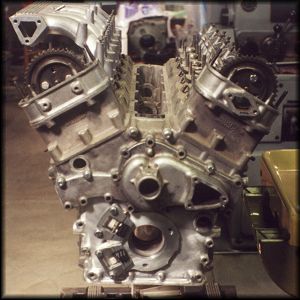

![]()
Jay Eitel's V-12 'Jaguair' Corvair
|
Many fine examples of V-powered Corvairs exist, from Crown and Kelmark style mid-engine configurations to rear mounted reverse rotation V-6 setups. When Jay Eitel decided to go V-powered, he chose another route, and mounted a Jaguar V-12 into the front of his Corvair. The results were so outstanding that, in December of 1997, Mr. Eitel was honored with a Special Recognition Award for Innovation and Spirit at the 8th Advanced Engine Technology Conference (AETC) in Colorado Springs, Colorado. Many of my fellow members of the Corvair Society of America (CORSA) have seen this car at national conventions. Mr. Eitel drove his superbly engineered "Jaguair" to both the 1993 and 1999 CORSA conventions held, respectively, in San Jose, California and Lake Tahoe, Nevada. Jay is an accomplished gentleman, known for inventing the "cherry picker," and when you make note of that fact, he'll modestly tell you, "Along with about 10 other people!" Although it is clear he gives credit where it's due, his innovation and creativity are surely his own, as we shall see on the following pages. |
|
In 1967, Jay bought his new Monza sport coupe because he liked its looks. However, he wasn't a big fan of air-cooled engines, and from the beginning, intended to redesign the car and install some "cubic inches." He had the engineering background, the energy, and the connections necessary to act on, and realize his dream. It would take lots of hard work, patience and persistence, but in his mind's eye, it was doable. |
|
|
His objective was to do it in such a way that the finished product would look and sound like a Corvair from both the inside and outside; a tall order when you consider his plan also included converting from a rear engine to front engine layout! The project began with the purchase of a junked late model Corvair, used as a test mule. He cut the floor out of it and after test fitting various components, finalized his plan and set about modifying the good car. It would take him between 2 and 3 years to complete the project. Normally, a front mounted engine would be mated to a conventional clutch or torque converter and transmission assembly directly behind the engine block. That approach was dismissed, as it would destroy one of the Corvair's highly touted and unique qualities, its flat floor and lack of an intrusive drive train hump. It would also shift the weight bias of the 2,700 pound vehicle (1000 lbs front/1700 rear) decidedly to the front, and radically alter the handling characteristics of the car. However, Eitel reasoned, the use of a "rather heavy" Pontiac Tempest trans-axle would place the weight of the transmission and differential assembly at the rear wheels, achieving a nearly ideal front/rear weight distribution of 48/52%. Installing the Pontiac trans-axle and its associated torque tube into the Corvair seemed, at one point, to be impossible. |
|
The Pontiac Tempest was built on a 112 inch wheel base, while the Corvair's wheel base is 108 inches. The drive shaft associated with the 2-speed automatic Pontiac trans-axle is impossible to cut. It is made of a very sophisticated composition of materials and is only 3/4" in diameter. |
|
|
In order to make it work, Jay had to do some serious digging around at General Motors. The secret involved some modifications to the transaxle by borrowing some tricks that had been used by GM drag racing teams in the early 60s (before the corporation got out of racing). At the time, 6 Tempest coupes and 6 station wagons with 421 cu. in. engines had been factory modified with 4-speed transaxles (by adding a second planetary 2-speed set) and a clutch in place of the torque converter. Using this information, Jay was able to source parts and make modifications inside the transaxle case to yield a torque converter and 4-speed transmission combination that would fit the Corvair wheel base. He chose a 2.9:1 final drive ratio for high speed cruising and reasonable fuel efficiency, and a top speed capability of 150 mph plus. He hasn't had it up there yet, but has clocked 120 mph at the top of third gear! |
|
At right, the famous '63 Tempest transaxle with the clutch. The front gear case is the Production Modified Powerglide with the torque converter mounted on the differential case. The second 2-speed planetary gear set yields perfect 4-speed ratios. Notice the starter mount near the torque converter case. The starter and battery add weight in the rear of the car. |
|
|
The Tempest drive train was one of the more unusual power trains built by General Motors. In the picture at right, notice the curve in the torque tube. It bends the 3/4" drive shaft approximately 4 inches, and as Jay points out, it was a clever design, as it allowed the floor the be lowered. |
|
|
Jay's "cubic inches" came from an aluminum block, 60° Jaguar V-12. He stroked the crankshaft nearly a quarter-inch to increase the engine's displacement to 347 cubic inches (5.69 Liters), and installed Chevrolet connecting rods. The pistons are stock Jaguar, with integral combustion chambers. The Jag cylinder heads were ported "just to clean them up." Due to the limitations of the Pontiac transaxle torque converter, which tends to balloon and blow up at around 6200 rpm, Jay decided there was no point in increasing valve size or enlarging the intake and exhaust ports. Doing so would only make the engine less manageable at off-idle and low rpm. At bottom center in the photo at right, note the two ignition pickups, spaced 60° apart, and set up to trigger two 6-cylinder ignition systems working in tandem. |
 |
Click the road sign for the more.
Select from the navigation bar!